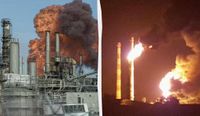In the early hours of October 6, 2025, a series of Ukrainian drone strikes set the Feodosia oil terminal ablaze, sending flames and thick black smoke billowing over Russian-occupied Crimea. The Feodosia facility, the region’s largest oil storage depot, can hold up to 250,000 tons of fuel and is a crucial supply point for Russian forces in Crimea. According to the General Staff of Ukraine’s Armed Forces, the attack was part of an intensified campaign targeting Russia’s energy infrastructure, with the fire at Feodosia visible from tens of kilometers away and continuing to spread to additional oil tanks well into the following day, as reported by The Kyiv Independent.
This latest strike isn’t an isolated incident—it’s the latest in a rapidly escalating series of Ukrainian attacks on Russian energy assets, both in occupied Crimea and deep inside Russian territory. Additional explosions rocked the Saki and Kacha airfields in Crimea that same night, and Ukrainian forces also targeted an ammunition depot belonging to Russia’s 18th Combined Arms Army. The results of that strike are still being assessed, but the message is clear: Ukraine is ramping up its efforts to disrupt Russia’s war logistics and energy supply lines.
The impact of these attacks is being felt far beyond the battlefield. Fuel shortages have worsened dramatically across occupied Crimea and the city of Sevastopol, with about 50% of gas stations halting gasoline sales as of late September, according to Russian business outlet Kommersant. The Southern Federal District, which Russia claims includes Crimea, has been among the hardest hit, with over 14% of stations suspending fuel sales. The shortages have forced authorities to cut public transport routes in Crimea, and the deficit now reaches 56% of demand, as reported by NEXTA.
Ukraine’s drone campaign is not limited to Crimea. In the past week alone, coordinated strikes have caused significant damage to the Novorossiysk oil export terminal on the Black Sea, a refinery complex in Bashkortostan (over 1,300 km from Ukraine), and a pumping station in Chuvashia (1,000 km from Ukraine), according to The Economist. On October 1, a major refinery in Yaroslavl was hit, and on the night of October 5, drones attacked the Nizhny Novgorod Lukoil refinery in Kstovo, Russia’s fourth-largest refinery. Drones also set off multiple explosions at the Sverdlov explosives plant in the Nizhny Novgorod region, 800 km from the Ukrainian border. The plant, sanctioned by both the European Union and the United States since 2023, is one of Russia’s largest producers of munitions, including warheads for precision-guided missiles and other military hardware.
Perhaps most striking is the scale of the damage: as of October 7, almost half of Russia’s oil refineries have been affected by Ukrainian drone and missile strikes, reports The Economist. Sixteen of Russia’s 38 refineries have been hit since August, according to the Financial Times, forcing Russian diesel exports to drop to their lowest level since 2020—a 30% decrease compared to last year, with diesel exports now at their lowest since 2020. This has led to a sharp rise in wholesale prices, and as Russia is the world’s second-largest diesel exporter, the consequences are reverberating across global markets.
How is Ukraine pulling off these deep strikes? The answer lies in a new generation of domestically produced drones and cruise missiles. About 60% of deep strikes on Russian territory are carried out by Fire Point FP-1 one-way attack drones. These drones, equipped with 60–120 kg warheads, can reach targets up to 1,500 km inside Russia and are produced at a rate of more than 100 units per day, according to weapons expert Olena Kryzhanivska, cited by The Economist. The FP-1s cost about $55,000 each and are equipped with sophisticated software that resists electronic warfare. Ukraine also deploys heavier “Liutyi” drones, which have a range of 2,000 km, and FP-5 “Flamingo” cruise missiles, which can carry a massive 1,150-kg warhead over 3,000 km. Fire Point currently produces two to three FP-5s per day, with plans to ramp up production to seven per day by the end of October 2025. Each cruise missile costs around $500,000 and is powered by rebuilt Soviet-era turbofan engines.
The frequency of these attacks has increased notably since August. What began as two to three strikes per week has now escalated to four or five, with coordinated attacks on refineries, pumping stations, and other critical infrastructure. The effects are cumulative and severe: pumping stations and storage facilities have been seriously damaged, including a massive attack in mid-September on Primorsk, Russia’s largest oil transshipment port on the Baltic Sea. Yet, as Serhii Vakulenko from the Carnegie Eurasia Center notes, such facilities are difficult to destroy permanently and there are no signs yet of a reduction in Russian crude oil exports. Still, the pressure is mounting.
On the Russian side, the government has responded to the fuel crisis by imposing new restrictions. On September 25, Russian Deputy Prime Minister Alexander Novak announced a partial ban on diesel exports and extended a previously imposed gasoline export ban until the end of the year. The bans are a direct response to the fuel shortages and export disruptions caused by Ukrainian strikes.
Meanwhile, Ukraine is reinforcing its own energy infrastructure. On October 7, President Volodymyr Zelensky announced the allocation of an additional 1.5 billion hryvnia (about $36 million) to bolster energy facilities in frontline regions. After meeting with Prime Minister Yulia Svyrydenko, Zelensky stated that the funds would go toward protecting critical infrastructure and creating a reserve of equipment for rapid power restoration. The government also pledged to maintain a fixed price for household natural gas and imposed a moratorium on cutting off power in frontline communities.
Internationally, the European Union is tightening restrictions on Russian diplomats, requiring them to inform authorities of travel plans before crossing borders within the bloc—a move aimed at countering sabotage attempts often linked to spies operating under diplomatic cover, according to EU officials. Denmark, for its part, is stepping up environmental checks on oil tankers in the Baltic-North Sea shipping lane, targeting Russia’s so-called “shadow fleet” used to evade sanctions. In a show of growing cooperation, Ukraine and Denmark signed a memorandum of understanding for joint defense manufacturing, including drones, to be produced in Denmark.
As for the United States, President Donald Trump has wavered on whether to supply Ukraine with long-range Tomahawk cruise missiles. When asked by reporters, he said he had “in a sense already made a decision” but added, “I think I want to find out what they’re doing with them. I would ask some questions. I’m not looking to escalate that war.” The provision of Tomahawks, which have a range of up to 1,600 km, would significantly enhance Ukraine’s ability to strike deep inside Russia.
British strategist Sir Lawrence Freedman summed up the strategic picture in The Economist: “Ukrainians are on the rise. The Russians have a problem. They cannot stop this, and Ukrainians have no reason to slow down.” As the drone war intensifies and the strikes grow bolder and more frequent, the energy battle between Ukraine and Russia is reshaping the conflict—and its consequences are being felt far beyond the front lines.




